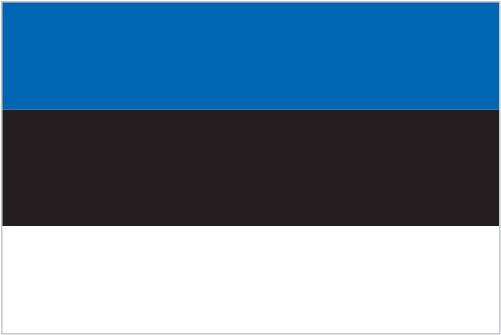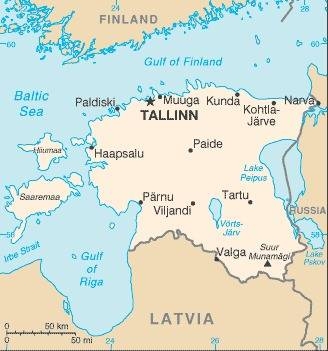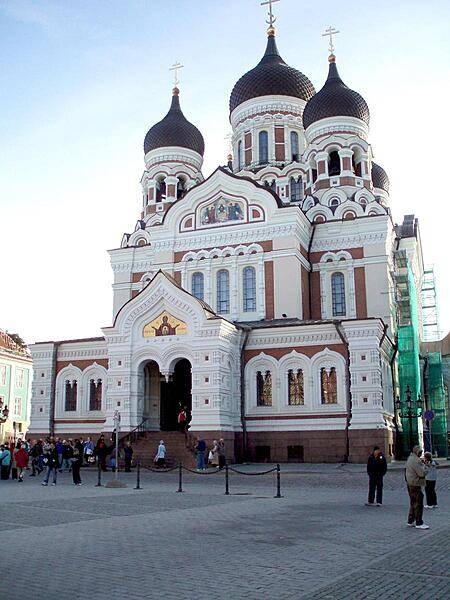66 Estonia

Three equal horizontal bands of blue (top), black, and white. Various interpretations are linked to the flag colors. Blue represents faith, loyalty, and devotion, while also reminiscent of the sky, sea, and lakes of the country. Black symbolizes the soil of the country and the dark past and suffering endured by the Estonian people. White refers to the striving towards enlightenment and virtue, and is the color of birch bark and snow, as well as summer nights illuminated by the midnight sun.
Flag courtesy of the CIA World Factbook

Map courtesy of the CIA World Factbook

Alexander Nevsky Cathedral in the upper town of Tallinn was completed in 1900.
Photo courtesy of the CIA World Factbook
Government
According to Britannica, among the many initiatives of the Estonian government after independence from the U.S.S.R. was declared in August 1991 were preparation of a constitution, including the protection of minority group rights; proposed negotiations with Russia over territory lost during border adjustments following the Soviet occupation of 1940; and the development of legislation that would assist in the conversion to a market economy. A new constitution, based largely on the 1938 document that provided the basis for Estonia’s pre-Soviet government structure, was approved by voters in a June 1992 referendum and came into effect in early July.
Guaranteeing the preservation of the Estonian nation and its culture, this document established a unicameral legislature, the Riigikogu (parliament), whose members are directly elected through proportional representation to four-year terms. The president, who serves as the head of state and supreme commander of the armed forces, is elected to not more than two consecutive five-year terms by the Riigikogu. Executive power rests with the prime minister, who is nominated by the president, and with the Council of Ministers. The government is responsible for implementing domestic and foreign policies and for coordinating the work of government institutions.
Estonia is divided into 15 maakonnad (counties), which are further divided into vallad (parishes). In addition to parish governments, there are administrative bodies for a number of towns and independent municipalities. The parishes are further divided into külad (villages) and asulad (townships).
The judiciary comprises rural, city, administrative, and criminal courts, regional and appellate courts, and the National Court, which is the court of final appeal. A legal chancellor is appointed by the Riigikogu to provide guidance on constitutional matters.
Estonia Transport Administration
The Estonian Transport Administration was created on 1 January 2021 by merging the Civil Aviation Administration, the Road Administration and the Maritime Administration, this becoming their legal successor.
Airspace
SkyVector – Google Maps – ADS-B Exchange
ICAO countries publish an Aeronautical Information Publication (AIP). This document is divided into three parts: General (GEN), En Route (ENR) and Aerodromes (AD). ENR 1.4 details the types of airspace classes they chose to adopt from classes A through G.
EANS
Aeronautical information service is provided by the AIM Department of Lennuliiklusteeninduse AS (Estonian Air Navigation Services).
Drone Regulations
Advanced Air Mobility (AAM) Regulations & Policies
Bilateral agreements facilitate the reciprocal airworthiness certification of civil aeronautical products imported/exported between two signatory countries. A Bilateral Airworthiness Agreement (BAA) or Bilateral Aviation Safety Agreement (BASA) with Implementation Procedures for Airworthiness (IPA) provides for airworthiness technical cooperation between the FAA and its counterpart civil aviation authorities.
Reciprocal acceptance of aviation safety-related approvals and services with the European Union Aviation Safety Agency (EASA) and Member States of the European Union are primarily governed by the U.S. – European Union Safety Agreement.
Advanced Air Mobility (AAM) News
2024 – ANRA Technologies partners with Estonian Aviation Academy to establish U-Space Test Center
2023 – Estonia Transforms Drone Operations with FREQUENTIS’ Cutting-Edge UTM Suite
2023 – Paris 2023: Thales reinforces support to Estonia for defense, including low altitude airspace
2023 – Estonia launches U-space sandbox with ANRA to expand development of drone services
Short Essay Questions
Scenario-Based Question
You have been hired by a Drone Startup Company. Your boss has immediately assigned this job to you.
They need you to prepare a one-page memo detailing the legalities of using a drone to film over Tallinn, pictured above.
They need you to mention any national laws and local ordinances.
They specifically want to know what airspace (insert pictures) you will be operating in and whether or not you need an airspace authorization.
Does it matter whether or not you are a citizen of the country?
Lastly, there is a bonus for you if, as you scroll through this chapter, you find any typos or broken links!
Short Essay Questions
- What are the drone categories?
- How is registration addressed?
- How is remote ID addressed?
- What are the model aircraft rules?
- What are the commercial drone rules?
- Are there waivers or exemptions to the rules? If so, for what?
- Would you share a link to an interactive airspace map?
- How is BVLOS addressed?
- How can you fly drones at night?
- How can you fly drones over people?
- Where do you find drone NOTAMs?
- What are the rules for drone maintenance?
- What are the rules for an SMS program?
- What are some unique rules not mentioned above?
- What are the C-UAS rules?
- What are the AAM rules?

